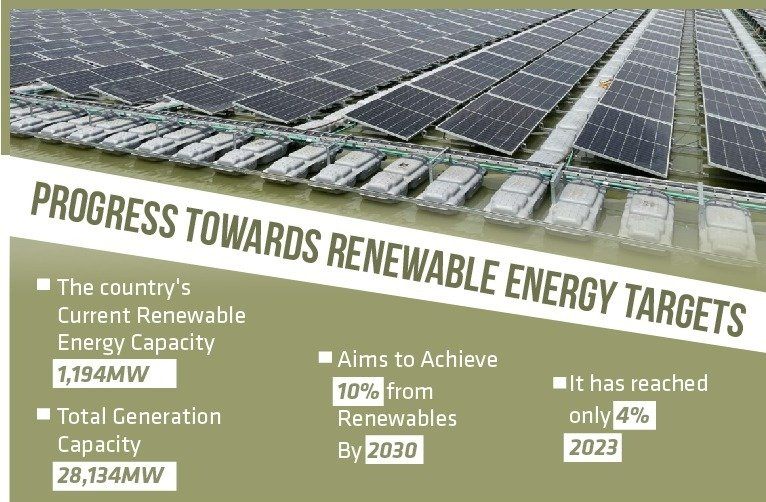With the increasing demand for sustainable and clean energy sources, countries around the world are exploring innovative solutions to meet their energy needs. Bangladesh, a nation with a growing appetite for electricity, has uncovered a promising avenue in the form of floating solar power. A recent study conducted by the International Finance Corporation (IFC) has determined that Bangladesh has the potential to generate approximately 11,000 megawatts peak (11GWp) of electricity from floating solar photovoltaics. The International Finance Corporation (IFC) conducted the study by evaluating 323 water bodies larger than 25 acres across the country.
You can also read:Is Dhaka’s Traffic Nightmare Ends with the Ashulia Expressway?
Out of these, 10 baors, beels, and lakes were identified as having a total potential of 10.8GWp electricity generation. Notably, the Barapukuria Coal Mine’s Lake and Kaptai Hydro Power’s Lake in Rangamati District can host 20MWp and 10,372MWp of solar photovoltaics, respectively. The remaining eight water bodies in eastern Bangladesh, namely Joydia Baor, Baluhar Baor, Marjat Baor, Katgara Beel, Bergobindopur Baor, Bukhbara Baor, Majdia Baor, and Jhapa Baor, offer the potential for 27-83MWp of solar electricity generation. The IFC is willing to finance utility-level floating solar projects in Bangladesh, and this technology is seen as a practical and cost-effective way to achieve the country’s solar power generation targets.
Floating Solar: A Game-Changer for Bangladesh
Floating solar, also known as floating photovoltaics (FPV) or photovoltaics, refers to the installation of solar panels on a floating platform positioned on bodies of water, including reservoirs, lakes, drinking water reservoirs, quarry lakes, irrigation canals, as well as remediation and tailing ponds. An increasing quantity of such systems exist in China, France, India, Japan, South Korea, the United Kingdom, Singapore, and the United States.
Floating solar power plants are installed on water bodies as an alternative to ground-mounted solar projects when land is limited. Sayef Tanzeem Qayyum, from the World Bank’s 2030 Water Resources Group, highlights the practicality and cost-effectiveness of Floating Solar PV (FSPV) for achieving solar power goals in Bangladesh. The International Finance Corporation (IFC) is willing to finance utility-level floating solar projects in Bangladesh to promote sustainable energy development. Private sector participation is crucial for maximizing solar power potential, but there is currently limited private sector interest in floating solar projects, hindering widespread adoption.
There have been recent investments in solar power in Bangladesh by local and foreign companies. Notable projects include Beximco Power’s 200MW solar power plant in Sundarganj and Orion Group’s 134MW solar power plant in Khulna. The World Bank Group is also interested in increasing its investments in Bangladesh’s renewable energy sector as part of a broader climate-smart investment opportunity. An agreement with the Sustainable and Renewable Energy Development Authority (SREDA) has been signed to support a 30MW capacity solar power plant in the Kushtia district.
Progress Towards Renewable Energy Targets
Bangladesh aims to achieve 10% of its power generation from renewables by 2030, but as of 2023, it has reached only 4% of this target. The country’s current renewable energy capacity stands at 1,194MW, out of a total generation capacity of 28,134MW, with solar energy dominating this sector. Floating solar power was a relatively new concept in Bangladesh until May of the current year when the first project, a 2.30MW installation in Bulanpur, Chapainawabganj, was connected to the national grid.

Japanese Sumitomo Corporation and Parker Bangladesh are collaborating to establish a substantial 200MW solar power plant, which includes a 50MW floating unit and a 150MW ground-mounted unit,
Bangladesh’s Ongoing Projects and Its Journey Toward Clean Energy
In order to join China, India, and the UAE in the gigawatt club, Bangladesh is currently implementing and considering over a dozen large-scale solar power plants, including three with a 1,000MW capacity each. One of these three is currently under construction in Noakhali at Swarna Dwip (formerly Jahazzair Char). Pacific Energy Group, LLC (Pacific Energy) of the United States, through its Hong Kong subsidiary Eleris Energy Limited, entered into a Joint Venture Agreement (JVA) with the Bangladesh Army Welfare Trust for constructing the plant in February of the previous year.
Since 2013, the 33rd Infantry Division of the Bangladesh Army has been responsible for the 370-square-kilometer island, where they have been implementing various development initiatives and establishing an exercise base.
According to sources in the Energy Ministry, the government is currently either reviewing or implementing major projects in Sreemangal, Moulvibazar (300MW), Mongla, Bagerhat, and Thakurgaon (both 200MW).
According to State Minister for Energy and Power Nasrul Hamid, Bangladesh generates 1,194 MW from renewable sources, but only 825.23 MW is integrated into the national grid. Another 1,262MW of renewable energy power plants are under construction through 30 projects, while 8,668MW of projects are in the planning phases.
Since 1996, Bangladesh has installed over six million Solar Home System (SHS) units, along with thousands of rooftop units, solar-powered street lighting and telecom BTS, and solar irrigation units. Moreover, several private companies have set up small solar power plants not connected to the grid, contributing to the promotion of renewable energy.
The solar share is expected to rise rapidly in the coming years, thanks to the government’s proactive steps to transition to renewable energy gradually. This initiative is poised to foster regional economic growth and reduce the dependence on power imports as solar power production gains momentum in global environmental conservation. Its significance extends beyond North Bengal’s borders, sustaining regional trade and employment.
Bangladesh’s potential to generate 11GWp of electricity from floating solar photovoltaics represents a significant step towards achieving sustainable and clean energy goals. While challenges related to environmental impact and private sector involvement must be addressed, the country’s commitment to renewable energy is a promising sign for a brighter, greener future. As investments continue to pour into the renewable energy sector, Bangladesh is well on its way to making substantial progress in its energy transition.


